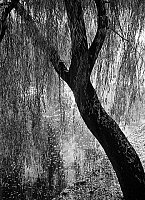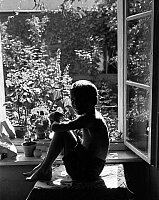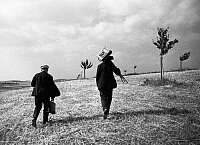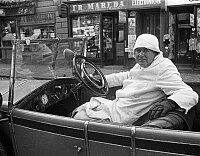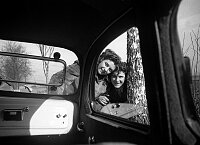Exhibited photographs
This exhibition was prepared to celebrate the completion of our project of digitizing all 300 rolls of 35mm film preserved from the work of Josef Jindřich Šechtl. It shows a selection from his Leica work. We have chosen 30 photo essays, and have displayed several photographs from each. The complete photo essays can be found in our digital archive.
- 1928

Exhibition of Professional Photographers in Brno- 1928, 1929

Christmas; From Bálkova Lhota to Pejšova Lhota by car- 1930–35

Drill of the František Palacký 11th Infantry Regiment- 1931

“Pupa first time at school, for school, from school, away from school”- 1931, 1932

Sokol swimming baths- 1932

Farmers’ Militia
Antonín Čermák, mayor of Chicago in Tábor- 1933

“Soccer from Rome, see also Ferenc Futurista”- 1932–35

Škoda car workshop on Vančurova Street- 1934

Cardinal Karel Kašpar in Pelhřimov
Beauty of Miličín- 1934–35

48th Regiment stuffing straw mattresses, Pelhřimov- 1935–36

Army music band, Pelhřimov
Trip with Milena and Cízlerová- 1936

Dresden
Berlin during the 1936 Olympic Games
Funeral of city mayor of Mladá Vožice Rudolf Žahour- 1938

Re-opening of railroad from Tábor to Bechyně, with František Křižík
3rd meeting of Jawa club
Xth Sokol meet (“Slet”) in Prague
President of Czechoslovakia, Edvard Beneš in Tábor- 1938–41

Building new hospital- 1938–39, 1944

Building Church of God's Warriors; Celebration of Czecho-Moravian Church- 1939–45

Signs of Occupation in Tábor
Exercises of Curatorium in Tábor- 1945

End of World War II- 1947

Orphanage in Kyselka- 1948

Reunion of WWII prisoners
Exhibition of posters
May 1st celebration
Funeral of President Edvard Beneš- 1948–54

Farmers at Grand Hotel- 1950

Apartment of actor Jaroslav Hurt in Tábor
Rebuilding Karolín
Photographs from opening day
Leica (Leitz Camera)
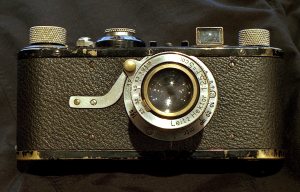
The Leica I (Pic 2), the first practical camera built to use 35 mm film (originally developed as movie film), was introduced in 1925. Because of its small size, excellent optics, reliable design and the easy availability of film, the new camera was an immediate success. “Small negatives — large images” was the slogan of Oskar Barnack, designer of the camera which was soon to change the world of photography.
While the technical quality of photographs taken on 35 mm film wasn’t comparable with that of photographs taken by cameras with large glass plate negatives (such as 13×18 cm), the small camera was readily available, inconspicuous, and the shots were reasonably cheap. It quickly brought about a new style of photography, where the photographer could take photographs of people on the streets without them being aware.
Josef Jindřich Šechtl and Leica
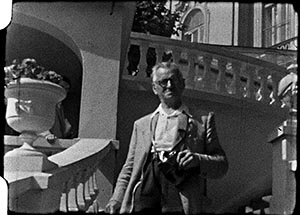
Josef Jindřich Šechtl (1877 – 1954) proprietor of the important Šechtl & Voseček portrait and photographic studio in Tábor, was also a passionate photo-journalist and documentary photographer. He first tried using the Leica while attending the first National Exhibition of Professional Photographers in Brno in 1928, and our oldest dated 35 mm film is from this exhibition. The camera he subsequently used is believed to have been bought for him as a Christmas present, for Christmas 1928. This made him one of the pioneers of 35 mm photography in Czechoslovakia. He used his Leica I camera, later upgraded to a Leica II, daily until his death in 1953. During this time, he photographed in great detail the events of the 1930s—a time of spreading industrialization, especially in the automobile industry, but also of financial crisis; World War II; and post-World War II, including the communist takeover in 1948. Partly through good fortune, and partly because of its small physical size, the whole archive was preserved in a family sideboard, without having been subject to any censorship.
Digitizing the archive
Our project of digitizing the archive of negatives preserved from the work of the Šechtl & Voseček Studios started in April 2004. The goal is to catalogue the whole archive and to make it available in this museum and on the Internet. We are trying to make the highest possible quality scans to avoid the need to re-scan negatives.
We began work on the archive of glass plate negatives, containing the oldest photographs. In three years, we have digitized 8,000 negatives, out of an estimated total of 10,000 –13,000 negatives.
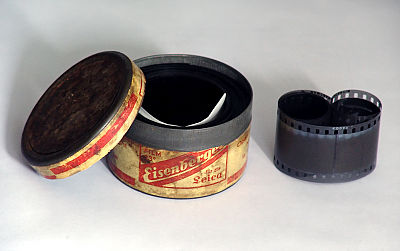
We only began exploring the 35 mm films left by Josef Jindřich Šechtl in 2005, because the collection was thought to contain only photographs of “old men”, from vacations in Yugoslavia, and at the spa in Jáchymov. We hoped that somewhere in all the rolls of film we had, we might find some interesting additions to our archive of glass plate negatives. Further motivation came from the recommendation we received from Kodak, to safely destroy the old nitrate films because of their chemical instability, and the slowly increasing likelihood of an explosion. Luckily our archive is in a relatively low state of deterioration, and thus we decided to fully digitize it. We were really surprised by the number of photo-essays we found, and also by the quality of the individual photographs, and by how well the pictures in the archive documented the times in which they were taken.
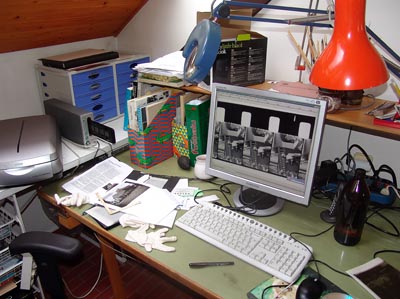
Digitization was done on a high quality Minolta 5400 film scanner with high resolution, 5400 DPI (40 megapixels). It has thus been possible to reproduce here almost all the photographs in the archive, in representative quality. Overall we have digitized about 300 films, comprising some 8,000 photographs.
You are welcome to explore our whole archive, either on the computer in our museum, or on the internet.
